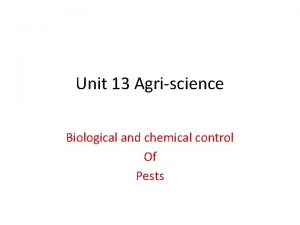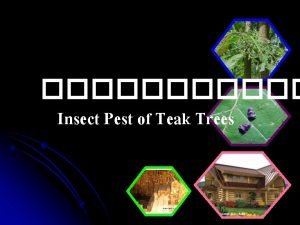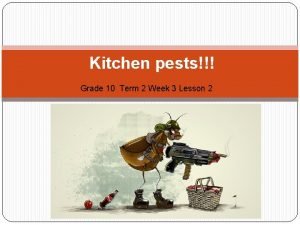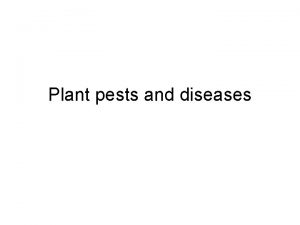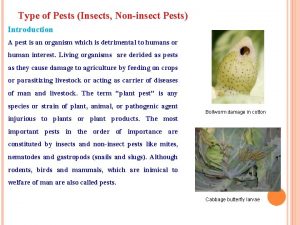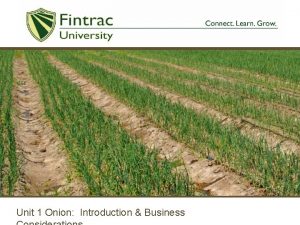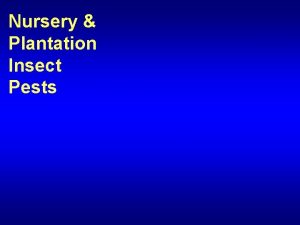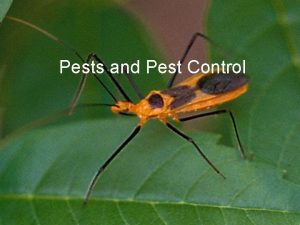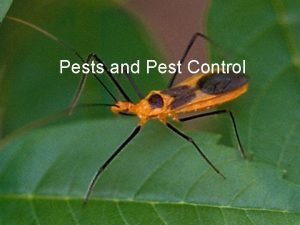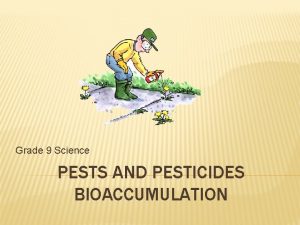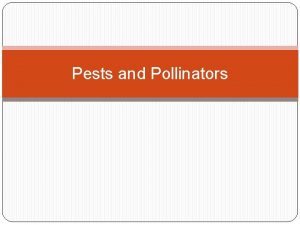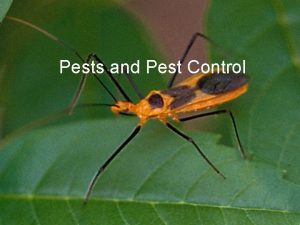Onion Important Pests Introduction Onion does not have










- Slides: 10

Onion: Important Pests

Introduction Onion does not have many pest problems. The most common insect pest is thrips. For this and other pests, Fintrac recommends the use of Integrated Pest Management (IPM). This approach is proactive, holistic and data driven. Here are the main components of an IPM program: • Production of a healthy crop – stress makes crops vulnerable to pest attack and unable to recover from damage. Healthy crops can take some pest damage and still be profitable. Improved seeds, proper land preparation, & good irrigation/nutrition/cultural programs will ensure a healthy crop. • Prevention – It takes less effort and money to prevent a pest problem than trying to control one. Crop rotation, weed control & protected nurseries are some ways to prevent pest attacks • Monitoring – the aim of regular scouting is to quickly identify pests that threaten the crop. Monitoring pest numbers in the field determines what control activities are needed (if any). • Integrated control activities – Farmers should understand all the options available to them to control pests. Pesticides are only one option and others such as pheromone traps can be very effective. • Record keeping – This is a critical but underappreciated part of IPM. For certification schemes such as Global. GAP, this is an important requirement. Record keeping helps understand the occurrence and development of pest problems and helps assess the effectiveness of control activities.

Thrips are tiny insects that feed on the plant sap by damaging the outer layer (epidermis) of the leaves. This results in small, white/silvery marks on the leaves. The marks can cover large areas of the leaf, cutting down the plant’s ability to photosynthesize. The plant can also become water stressed due to the loss of fluids from thrips feeding. The damage done to the plant also gives easy entrance for diseases. Severe infestations result in collapse of the plant and large reductions in yields. Infestation levels are most severe during hot, dry periods. The most common and damaging species found in onion are Onion thrips (Thrips tabaci) & Western flower thrips (Frankliniella occidentalis). The thrips’ life cycle is 15 -30 days depending on temperature. Nymphs are a clear yellow color while adults are bigger (~2 mm) darker and have wings. Both hide in the base of the leaves. These insects have a wide host range, and so will also be found in surrounding weeds. Thrips nymphs and the silvery damage to onion leaves

Thrips: management Scouting is an important part of the control program and sticky traps are a good way of monitoring thrips populations. The adults are attracted to yellow or blue surfaces. The flowers of weeds is another good place to look for adult thrips. Blowing into the flower disturbs the thrips and makes them easier to spot. Weed control is important to lower thrips populations. Insecticides are effective but they need to be applied properly: • Apply with high volumes of water – up to 1, 000 L/ha - so that the insecticide reaches into the leaf axils, where the insects are hiding. Farmers often think that they only have to use a small quantity of water because the plants don’t have much foliage. • Apply during the cool of the day when the thrips leave their hiding place inside the leaf axils and are more active. Treatment normally begins during bulb formation. Some varieties are more tolerant of thrips than others. Thrips nymphs hide in the base of the leaves

Lepidopteran Larvae Moth larvae are capable of damaging an onion crop if they are not detected and treated early. A common lepidopteran pest is the Beet armyworm (Spodoptera exigua – Noctuidae family). Like other species, this pest feeds on the leaves, lowering yield and giving entry to diseases. Often the larvae enter the leaves to feed inside, which makes their control very difficult. First instar larvae emerging from the egg mass (perfect time to control the pest) The top priority, is to detect egg masses and recently emerged larvae so that they can be controlled before entering the leaves. Scouting at least twice a week is recommended. Other lepidopteran species act as cutworms, killing seedlings by feeding on them at soil level (e. g. Black cutworm, Agrostis ipsilon).

Onion Maggots (Delia antiqua & D. platura) These fly larvae attack the seeds, seedlings and developing onion bulbs. They are generally considered a temperate or sub-tropical pest. Both of these species are more of a problem in soils with a lot of organic matter. Once they are established, they have the potential to be a problem every year. Delia platura (seedcorn maggot) attacks the seeds and seedlings, leading to reduced germination and seedling death. It is found in warmer areas than Delia antiqua (onion maggot). Greater damage is done to the plants when conditions are cool and wet and plant growth is slow. Delia antiqua is capable of damaging developing onion bulbs with the maggots or larvae feeding both externally and internally on the bulb. Initial above-ground symptoms are the yellowing and wilting of the leaves. Management: avoid applying manures or composts to the soil, this attracts the adults. Insecticide seed treatments or application of granular soil insecticides are capable of early control. Once larvae are inside the bulbs, they are difficult to control. Seedcorn maggot adult fly. Credit: Martin Cooper (CC by 2. 0)

Onion bulb mites (Rhizoglyphus spp. , Tyrophagus spp. ) These round, off-white mites are up to a millimeter in length. They have a global distribution, a wide host range and are found feeding on many different types of roots, tubers and bulbs. While they do attack healthy tissue, they seem to prefer bulbs that are already being attacked by soil fungi such as Fusarium. Damaged plants lose their roots resulting in stunting and poor bulb development. If germinating seedlings are attacked, they can lose the developing root (radicle) which can lead to seedling death. Damage is most severe when conditions are cool and wet. The mites also damage the outer layers of the bulb, which allows entry of disease pathogens. This can cause storage rots. The mites feed on decaying organic matter and use this ability to survive in fields between crops. Leaving a field fallows this material to fully breakdown. There are limited pesticide options; soil fumigants such as metam sodium are the most effective, but their use is restricted in many countries. A few carbamates and organophosphates are effective but insecticide resistance is a problem.

Nematodes are microscopic, worm-like organisms that live in the soil. They pierce plant cells and suck out their contents, damaging the plants in various ways. They have a wide host range and are difficult to control. These pests are more of a problem in sandy soils and often crop damage is seen first in localized areas of the field where populations are high. The main nematode pests of onions are: • • • Stem & Bulb Nematode (Ditylenchus dipsaci): Feeds inside the leaves and bulbs. The leaves become deformed and start to yellow. These symptoms can be confused with wilting. Damaged bulbs are soft and discolored. Most of the damage is in the inner scales or rings. Root Knot Nematode (Meloidogyne spp. ): Induce galls or ‘knots’ in the roots. In onion, the knots are smaller than normal, because the plant cuts off its own roots to prevent the nematode developing. Due to root loss and nematode activity, crop yields are low. Stubby Root Nematode (Paratrichodorus spp. ): Feed externally on the onion roots, causing them to branch profusely and develop necrotic, stubby tips. Plants are stunted and yields are low. Needle Nematode (Longidorus elongatus): Feeds on the tips of the roots causing excessive branching and swollen root tips. The plants become stunted, leaves turn yellow and yields are low. Root Lesion Nematode (Pratylenchus penetrans): Prevents the development of fine roots and causes lesions on the larger roots. Plants are stunted, and yields are low. Unlike the other nematode species, this nematode species has too wide a host range to make crop rotation a worthwhile management practice.

Other Pests There are other minor or less common pests found in onion: Leafminers (Lyriomyza spp. & Phytomyza gymnostoma): These fly larvae feed within the leaves and reduce the plant’s ability to photosynthesize. The damage also gives entry to diseases. Easily detected by their characteristic mines. Aphids (e. g. Myzus ascaloniscus, M. persicae & Aphis fabae): In general they do not cause economic damage unless they transmit virus diseases such as onion yellow dwarf potyvirus (OYDV). Wire worms (e. g. Agriotes spp): These generalist pests attack all Leafminer damage. underground parts of onion and can kill young seedlings. They are a Credit: H. F. Schwartz particular problem on recently cultivated grasslands. (CC by 3. 0) Spider mites (Tetranychus spp. ): Can potentially become a problem, especially in hot, dry conditions. These mites attack the foliage (unlike the bulb mites) and cause a characteristic whitening of the leaves that reduces photosynthesis. They also produce a fine webbing that becomes noticeable when infestation levels are high.

Conclusion Onion does not suffer from as wide a range of pests as other crops but those that do attack the crop can be difficult to control. • Thrips are the main pest of onion and they can be a challenge to control because of their tendency to hide in the base of the leaves. Insecticides should be applied early morning when conditions are cool and the thrips are active on the plant. High volumes of water and spreader stickers should also be used to allow the insecticide to reach the insects’ hiding place. • A number of pests are found in the soil (e. g. bulb mites, wireworms, nematodes), which make them more difficult to detect. Damage is often first detected by the wilting and necrosis of the leaves. • Lepidoteran or moth larvae need to be detected at the egg or first instar stage. Not only are they easier to kill when small, but they are prevented from entering the hollow leaf where they are protected from insecticides. This concludes the unit on Onion Pests. In the next unit, we will cover Onion Diseases.
 Which nutrient practice was best journey 2050
Which nutrient practice was best journey 2050 How does a plant resist disease and pests journey 2050
How does a plant resist disease and pests journey 2050 Agriscience unit 13 completion answers
Agriscience unit 13 completion answers Poinsettia pests
Poinsettia pests Teak insect pests
Teak insect pests Pests can cause which two types of contamination
Pests can cause which two types of contamination Bug infestation in house
Bug infestation in house Vocab level d unit 3
Vocab level d unit 3 Prism with 2 hexagonal faces and 6 rectangular faces
Prism with 2 hexagonal faces and 6 rectangular faces Example of a news story
Example of a news story From most important to least important in writing
From most important to least important in writing


